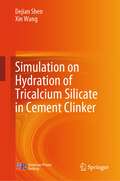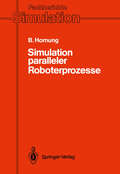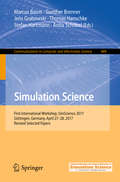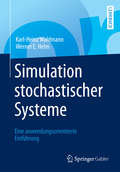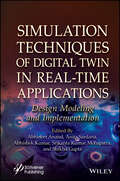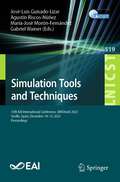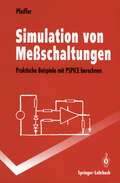- Table View
- List View
Simulation of Semiconductor Devices and Processes: Vol.5
by Siegfried Selberherr Hannes Stippel Ernst StrasserThe "Fifth International Conference on Simulation of Semiconductor Devices and Processes" (SISDEP 93) continues a series of conferences which was initiated in 1984 by K. Board and D. R. J. Owen at the University College of Wales, Swansea, where it took place a second time in 1986. Its organization was succeeded by G. Baccarani and M. Rudan at the University of Bologna in 1988, and W. Fichtner and D. Aemmer at the Federal Institute of Technology in Zurich in 1991. This year the conference is held at the Technical University of Vienna, Austria, September 7 - 9, 1993. This conference shall provide an international forum for the presentation of out standing research and development results in the area of numerical process and de vice simulation. The miniaturization of today's semiconductor devices, the usage of new materials and advanced process steps in the development of new semiconduc tor technologies suggests the design of new computer programs. This trend towards more complex structures and increasingly sophisticated processes demands advanced simulators, such as fully three-dimensional tools for almost arbitrarily complicated geometries. With the increasing need for better models and improved understand ing of physical effects, the Conference on Simulation of Semiconductor Devices and Processes brings together the simulation community and the process- and device en gineers who need reliable numerical simulation tools for characterization, prediction, and development.
Simulation of Semiconductor Processes and Devices 1998: SISPAD 98
by Kristin De Meyer Serge BiesemansThis volume contains the proceedings of the 1998 International Conference on Simulation of Semiconductor Processes and Devices and provides an open forum for the presentation of the latest results and trends in modeling and simulation of semiconductor equipment, processes and devices. Topics include: • semiconductor equipment simulation • process modeling and simulation • device modeling and simulation of complex structures • interconnect modeling • integrated systems for process, device, circuit simulation and optimisation • numerical methods and algorithms • compact modeling and parameter extraction • modeling for RF applications • simulation and modeling of new devices (heterojunction based, SET’s, quantum effect devices, laser based ...)
Simulation of Semiconductor Processes and Devices 2004
by Gerhard Wachutka Gabriele SchragThis volume contains the proceedings of the 10th edition of the International Conference on Simulation of Semiconductor Processes and Devices (SISPAD 2004), held in Munich, Germany, on September 2-4, 2004. The conference program included 7 invited plenary lectures and 82 contributed papers for oral or poster presentation, which were carefully selected out of a total of 151 abstracts submitted from 14 countries around the world. Like the previous meetings, SISPAD 2004 provided a world-wide forum for the presentation and discussion of recent advances and developments in the theoretical description, physical modeling and numerical simulation and analysis of semiconductor fabrication processes, device operation and system performance. The variety of topics covered by the conference contributions reflects the physical effects and technological problems encountered in consequence of the progressively shrinking device dimensions and the ever-growing complexity in device technology.
Simulation of Semiconductor Processes and Devices 2007: SISPAD 2007
by Tibor Grasser Siegfried SelberherrThis volume contains the proceedings of the 12th International Conference on Simulation of Semiconductor Processes and Devices, SISPAD 2007, held September 2007 in Vienna, Austria. It provides a global forum for the presentation and discussion of recent advances and developments in the theoretical description, physical modeling and numerical simulation and analysis of semiconductor fabrication processes, device operation and system performance.
Simulation of Thermal Systems: A Modular Program with an Interactive Preprocessor (EMGP 3)
by W.L. DutréThe events leading up to the publication of this book started effectively in 1976 with the exchange of information between those modelling teams in Europe which were involved in the R&D-programme on Solar Energy of the Commission. When it became clear that the availability of experimental datafor model validation wm next to nothing, the Commission took the initiative to support in the frame of the Solar Energy R&D-programme the construction of Solar Pilot Test Facilities on eight sites in Europe. Each experimental facility consisted of two real solar heating systems with collectors, storage, controls, and msociated piping, but with the dwelling thermal distribution system replaced by a physical load simulator. One of the two systems on each site wm a reference system and wm identical for the eight participating teams. The simulator wm capable of producing a typical themalload for a house, interactive with the actual weather, and took into account the effects of the occupants. With datafrom these facilities not only were national simulation programs validated, but also the meanwhile commonly accepted modular structured European program EMGPl wm validated. EMGPl, which only could be run on a mainframe computer or under special conditions on a mini-computer,formed in tum the bmis for the development of EURSOL andEMGP3.EMGP3 is an improved userjriendly programpackagejorpersonal computers derived jrom EMGPl and includes a unique and user jriendly preprocessor.
Simulation of Urban Mobility: First International Conference, SUMO 2013, Berlin, Germany, May 15-17, 2013. Revised Selected Papers (Lecture Notes in Computer Science #8594)
by Michael Behrisch Daniel Krajzewicz Melanie WeberThis book constitutes the thoroughly refereed proceedings of the First International Conference on Simulation of Urban Mobility, SUMO 2013, held in Berlin, Germany, in May 2013. The 12 revised full papers presented tin this book were carefully selected and reviewed from 22 submissions. The papers are organized in two topical sections: models and technical innovations and applications and surveys.
Simulation on Hydration of Tricalcium Silicate in Cement Clinker
by Dejian Shen Xin WangThis book is written based on authors' research on cement hydration during the past decade. It establishes simulation model to evaluate the influence of crystal defects on the dissolution of tricalcium silicate and morphology change of particles and explores the hydration kinetics and microstructure development of tricalcium silicate under the mixed control of dissolution, diffusion, as well as boundary nucleation and growth. It also provides a theoretical basis for regulating the microstructure and performance of cement-based materials. It is designed as a reference work for professionals or practitioners and as a textbook for undergraduates or postgraduates. This book provides valuable knowledge and useful methods that can be applied in the field of cement hydration.
Simulation paralleler Roboterprozesse: Ein System zur rechnergestützten Programmierung komplexer Roboterstationen (Fachberichte Simulation #14)
by Bernhard HornungEin System - SP3R - zur graphischen Programmierung und Simulation wird vorgestellt. Es ist geeignet, Aktionen in Roboterzellen in hoher Auflösung parallel zu simulieren und Fehler mit geringstmöglichem Aufwand zu korrigieren. Zur Repräsentation komplex aufgebauter Roboterstationen wird ein topologisches Modell der Zellkomponenten nach Baumstruktur verwendet; periphere Geräte können in den Programmablauf einbezogen werden. Über die Anwendungen in der Robotik hinaus gibt das Buch einen Überblick darüber, wie parallele Prozesse in komplex strukturierten Modellwelten effizient programmiert und detailliert simuliert werden können. Durch die Methoden der Computergraphik kann die Roboterszene mit einer Animation in Realzeit präsentiert werden.
Simulation Science: First International Workshop, SimScience 2017, Göttingen, Germany, April 27–28, 2017, Revised Selected Papers (Communications in Computer and Information Science #889)
by Marcus Baum Gunther Brenner Jens Grabowski Thomas Hanschke Stefan Hartmann Anita SchöbelThis book constitutes the thoroughly refereed proceedings of the Clausthal-Göttingen International Workshop on Simulation Science, held in Göttingen, Germany, in April 2017. The 16 full papers presented were carefully reviewed and selected from 40 submissions. The papers are organized in topical sections on simulation and optimization in networks, simulation of materials, distributed simulations.
Simulation Science: Second International Workshop, SimScience 2019, Clausthal-Zellerfeld, May 8-10, 2019, Revised Selected Papers (Communications in Computer and Information Science #1199)
by Nina Gunkelmann Marcus BaumThis book constitutes the refereed proceedings of the Second International Workshop on Simulation Science, held in Clausthal-Zellerfeld, in May 2019. The 12 full papers were carefully reviewed and selected from 47 submissions. The papers are organized according to the following topics: optimization and distributed simulations; simulation of materials; self-organized and porous structures; simulation of materials: finite element and multiscale methods.
Simulation stochastischer Systeme: Eine anwendungsorientierte Einführung (PDF)
by Werner E. Helm Karl-Heinz WaldmannDas vorliegende Lehrbuch ist eine umfassende Einführung in die Simulation stochastischer Systeme. Auf 400 Seiten wird der Leser an stochastische Simulationsmodelle, Lösungsmethoden und statistische Analyseverfahren herangeführt. Die grundlegenden Sachverhalte werden ausführlich motiviert und begründet. Das Buch kann im Bachelor- und Masterbereich an Universitäten und Hochschulen eingesetzt werden. Untersuchungsgegenstand und Herangehensweise machen es interessant für Wirtschaftswissenschaftler, aber auch für Ingenieure, Mathematiker und Naturwissenschaftler. Vorausgesetzt werden die Grundbegriffe der Wahrscheinlichkeitsrechnung und elementaren Statistik; die tatsächlich benötigten Elemente werden im Anhang bereitgestellt. Das Buch ist stringent in der Darstellung. Es ermöglicht ‚Learning by Example‘ und ‚Learning by Doing‘ und kann zum Selbststudium verwendet werden. Jedes neue Konzept wird durch Beispiele, Abbildungen und Aufgaben begleitet, die ein schnelles Verstehen und Übertragen auf eigene Problemstellungen ermöglichen.
Simulation störanfälliger Systeme: Praxisorientierte Modelle und deren Einsatz auf Mikrocomputern zur betriebswirtschaftlichen Bewertung von Störungen komplexer Systeme (Bochumer Beiträge zur Unternehmensführung und Unternehmensforschung #29)
by Peter ChamoniSimulation Techniques of Digital Twin in Real-Time Applications: Design Modeling and Implementation
by Abhineet Anand Anita Sardana Abhishek Kumar Srikanta Kumar Mohapatra Shikha GuptaSIMULATION TECHNIQUES OF DIGITAL TWIN IN REAL-TIME APPLICATIONS The book gives a complete overview of implementing digital twin technology in real-time scenarios while emphasizing how this technology can be embedded with running technologies to solve all other issues. Divided into two parts with Part 1 focusing on simulated techniques in digital twin technology and Part 2 on real-time applications of digital twin technology, the book collects a significant number of important research articles from domain-specific experts. The book sheds light on the various techniques of digital twin technology that are implemented in various application areas. It emphasizes error findings and respective solutions before the actual event happens. Most of the features in the book are on the implementation of strategies in real-time applications. Various real-life experiences are taken to show the proper implementation of simulation technologies. The book shows how engineers of any technology can input their research ideas to convert to real scenarios by using replicas. Hence, the book has a collection of research articles from various engineers with expertise in different technologies from many regions of the world. It shows how to implement the embedded real-time data into technologies. Specifically, the chapters relate to the auto landing and cruising features in aerial vehicles, automated coal mining simulation strategy, the enhancement of workshop equipment, and implementation in power energy management for urban railways. This book also describes the coherent mechanism of digital twin technologies with deep neural networks and artificial intelligence. Audience Researchers, engineers, and students in computer science, software engineering and industrial engineering, will find this book to be very useful.
Simulation Techniques of Digital Twin in Real-Time Applications: Design Modeling and Implementation
by Abhishek Kumar Shikha Gupta Abhineet Anand Anita Sardana Srikanta Kumar MohapatraSIMULATION TECHNIQUES OF DIGITAL TWIN IN REAL-TIME APPLICATIONS The book gives a complete overview of implementing digital twin technology in real-time scenarios while emphasizing how this technology can be embedded with running technologies to solve all other issues. Divided into two parts with Part 1 focusing on simulated techniques in digital twin technology and Part 2 on real-time applications of digital twin technology, the book collects a significant number of important research articles from domain-specific experts. The book sheds light on the various techniques of digital twin technology that are implemented in various application areas. It emphasizes error findings and respective solutions before the actual event happens. Most of the features in the book are on the implementation of strategies in real-time applications. Various real-life experiences are taken to show the proper implementation of simulation technologies. The book shows how engineers of any technology can input their research ideas to convert to real scenarios by using replicas. Hence, the book has a collection of research articles from various engineers with expertise in different technologies from many regions of the world. It shows how to implement the embedded real-time data into technologies. Specifically, the chapters relate to the auto landing and cruising features in aerial vehicles, automated coal mining simulation strategy, the enhancement of workshop equipment, and implementation in power energy management for urban railways. This book also describes the coherent mechanism of digital twin technologies with deep neural networks and artificial intelligence. Audience Researchers, engineers, and students in computer science, software engineering and industrial engineering, will find this book to be very useful.
Simulation Technologies in Networking and Communications: Selecting the Best Tool for the Test
by Al-Sakib Khan Pathan Muhammad Mostafa Monowar Shafiullah KhanSimulation is a widely used mechanism for validating the theoretical models of networking and communication systems. Although the claims made based on simulations are considered to be reliable, how reliable they really are is best determined with real-world implementation trials.Simulation Technologies in Networking and Communications: Selecting th
Simulation Tools and Techniques: 13th EAI International Conference, SIMUtools 2021, Virtual Event, November 5-6, 2021, Proceedings (Lecture Notes of the Institute for Computer Sciences, Social Informatics and Telecommunications Engineering #424)
by Dingde Jiang Houbing SongThis proceedings constitutes the refereed post-conference proceedings of the 13th International Conference on Simulation Tools and Techniques, SIMUTools 2021, held in November 2021. Due to COVID-19 pandemic the conference was held virtually. The 63 revised full papers were carefully selected from 143 submissions. The papers focus on new results in the field of system modeling and simulation, software simulation, communication networks’ modeling and analysis, AI system simulation and performance analysis, big data simulation analysis, addressing current and future trends in simulation techniques. They are grouped in thematic aspects on wireless communication, big data, modeling and simulation, deep learning, network simulation and life and medical sciences.
Simulation Tools and Techniques: 15th EAI International Conference, SIMUtools 2023, Seville, Spain, December 14-15, 2023, Proceedings (Lecture Notes of the Institute for Computer Sciences, Social Informatics and Telecommunications Engineering #519)
by Agustín Riscos-Núñez José-Luis Guisado-Lizar María-José Morón-Fernández Gabriel WainerThis proceedings constitutes the refereed post-conference proceedings of the 15th International Conference on Simulation Tools and Techniques, SIMUTools 2023, held in Seville, Spain, in December 2023. The 23 revised full papers were carefully selected from 58 submissions. The papers focus on various areas such as Simulation Tools and Methods; Artificial Intelligence and Simulation; Transportation and Logistics; Medical Sciences; and Network Simulations.
Simulation Tools and Techniques: 11th International Conference, SIMUtools 2019, Chengdu, China, July 8–10, 2019, Proceedings (Lecture Notes of the Institute for Computer Sciences, Social Informatics and Telecommunications Engineering #295)
by Houbing Song Dingde JiangThis volume constitutes the refereed post-conference proceedings of the 11th International Conference on Simulation Tools and Techniques, SIMUTools 2019, held in Chengdu, China, in August 2019. The 97 revised full papers were carefully selected from 156 submissions. The papers focus on simulation methods, simulation techniques, simulation software, simulation performance, modeling formalisms, simulation verification and widely used frameworks.
Simulation Tools and Techniques: 12th EAI International Conference, SIMUtools 2020, Guiyang, China, August 28-29, 2020, Proceedings, Part II (Lecture Notes of the Institute for Computer Sciences, Social Informatics and Telecommunications Engineering #370)
by Houbing Song Dingde JiangThis two-volume set constitutes the refereed post-conference proceedings of the 12th International Conference on Simulation Tools and Techniques, SIMUTools 2020, held in Guiyang, China, in August 2020. Due to COVID-19 pandemic the conference was held virtually. The 125 revised full papers were carefully selected from 354 submissions. The papers focus on simulation methods, simulation techniques, simulation software, simulation performance, modeling formalisms, simulation verification and widely used frameworks.
Simulation Tools and Techniques: 12th EAI International Conference, SIMUtools 2020, Guiyang, China, August 28-29, 2020, Proceedings, Part I (Lecture Notes of the Institute for Computer Sciences, Social Informatics and Telecommunications Engineering #369)
by Houbing Song Dingde JiangThis two-volume set constitutes the refereed post-conference proceedings of the 12th International Conference on Simulation Tools and Techniques, SIMUTools 2020, held in Guiyang, China, in August 2020. Due to COVID-19 pandemic the conference was held virtually. The 125 revised full papers were carefully selected from 354 submissions. The papers focus on simulation methods, simulation techniques, simulation software, simulation performance, modeling formalisms, simulation verification and widely used frameworks.
Simulation Training: Improving Professional Practice Through Simulation Training
by Philippe Fauquet-Alekhine Nane PehuetDrawing on decades of industrial experience, this insightful and practical guide uses case studies and an interdisciplinary perspective to explain the fundamentals of simulation training to improve performance of high-risk professional activities. It seeks to identify those conditions under which simulation training has been shown to improve professional practice while employing extensive real examples. Simulation Training: Fundamentals and Application helps readers to develop their own synthesis of the simulation learning method and to use such training to enhance their skills and performance. Case studies demonstrate five specific theatres of professional practice - the nuclear-power industry, aeronautics, surgery, anesthesia and metallurgy – and then detailed analysis highlights the common factors and key results. The author’s background as a Human Factors Consultant, Physicist and Physiologist has enriched studies of humans in work situations, work organization and management and he has also been involved in pedagogical conception of experimental training on simulators based on his experience as a safety expert on nuclear power plant. The book is useful to practitioners, researchers and students, both in industry and in university. It is clearly cross disciplinary as it presents and discusses applications in engineering, professional practice (airline pilots) and medicine.
Simulation und moderne Programmiersprachen: Modula-2, C, Ada (Fachberichte Simulation #8)
by Bernd Page Rolf Bölckow Andreas Heymann Ralf Kadler Hansjörg LiebertSimulation und Optimierung in Produktion und Logistik: Praxisorientierter Leitfaden mit Fallbeispielen (VDI-Buch)
by Lothar März, Wilfried Krug, Oliver Rose and Gerald WeigertDie simulationsgestützte Optimierung von Produktportfolios und Produktionsketten birgt großes Potenzial – Berichte über Kopplungen von Simulation und Optimierung sind aber rar. Der Band liefert erstmals deutschsprachige Anwendungsbeispiele und einen Überblick über die Möglichkeiten von Simulation und Optimierung. Anders als standardisierte Planungsansätze können mithilfe der Simulation auch dynamische Produktions- und Logistikprozesse analysiert werden. Bei gezielter Vernetzung von Logistikabläufen lassen sich so unerwünschte Liegezeiten vermeiden.
Simulation von Meßschaltungen: Praktische Beispiele mit PSPICE berechnen (Springer-Lehrbuch)
by Wolfgang PfeifferDies ist ein Lehr- und Übungsbuch für die Simulation von elektrischen Schaltungen mit PSPICE, wie sie in der Vorlesung Meßtechnik für Studenten der Elektrotechnik an Hochschulen und Fachhochschulen behandelt werden. Die Grundvorlesungen über elektrische Meßtechnik müssen heutzutage verstärkt auf die Schaltungssimulation eingehen. Das Buch bearbeitet die für die Prüfung und Praxis wichtigsten und aktuellsten Schaltungsbeispiele in anschaulicher Darstellung, wobei auch jeweils die Codierungen in PSPICE mit angegeben werden. Dabei wird auf die Demonstration der typischen und wesentlichen Eigenschaften der Meßschaltungen besonderer Wert gelegt. Es ist sinnvoll und hilfreich, die Beispiele auf dem Rechner mit PSPICE nachzuvollziehen. Aber auch ohne diese Möglichkeit kann das Wesentliche über Meßschaltungen aus diesem Buch gelernt werden.
Simulation von Produktionssystemen
by Jan Kosturiak Milan GregorSeit einigen Jahren entwickelt sich Computersimulation zu einem unentbehrlichen Werkzeug in der Planung von Produktionssystemen, Unternehmenslogistik und Produktionsplanung und -steuerung. Systeme, die mit dieser Technik analysiert und gesteuert werden, wurden in den letzten Jahren stark verändert. Automatisierte, komplexe Produktionssysteme, dezentrale Organisationsstrukturen, schlanke Produktion und der "kontinuierliche Verbesserungsprozeß"in der Produktion - das alles stellt auch neue Anforderungen an die Simulationstechnik und ihre Benutzer. Das Buch führt in die Simulationstechnik und ihre theoretischen Grundlagen ein und gibt einen Überblick über Methodik und Anwendungen. Es dient Studenten als Lehrbuch und hilft Ingenieuren und Planern in Betrieben, die sich in die Thematik einarbeiten wollen.






